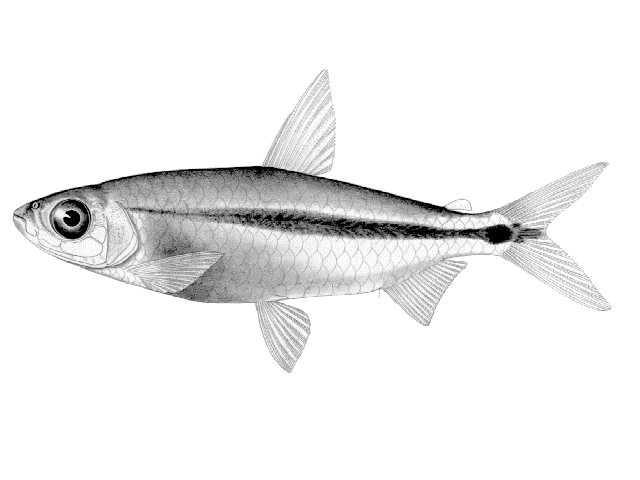
|
Brycinus lateralis (Boulenger, 1900) Stripped robber |

|
|
photo by
Mertens, P. |
| Family: | Alestidae (African tetras) | |||
| Max. size: | 14 cm SL (male/unsexed) | |||
| Environment: | pelagic; freshwater, potamodromous | |||
| Distribution: | Africa: Kasai, upper Sankuru, upper Lualaba (Ref. 42019) and Luapula systems (Ref. 45616, 109499) (middle and upper Congo River basin) in Democratic Republic of the Congo and Zambia. Zambezi system including upper Zambezi, Kafue, Lake Kariba, lower Zambezi, Okavango, Cunene, Buzi (Ref. 7248, 94654) and Caprivi strip (Ref. 37065). Also from coastal north-east Natal to the Lake St. Lucia catchment (Ref. 13332). | |||
| Diagnosis: |
Dorsal spines (total): 0-0; Dorsal soft rays (total): 10-11; Anal spines: 0-0; Anal soft rays: 18-19. Diagnosis: A slimmer fish than Brycinus imberi without a spot behind the head, but with a pronounced black lateral band (normally only visible on dead material) which ends in a caudal dash extending right through the caudal fin (Ref. 13337). Description: Body fusiform, leading rays of anal fin extended in males, forming rounded edge, edge straight in immatures and females; head about equal to body depth, mouth terminal, jaws each with 2 rows of sharp tricuspid teeth (Ref. 52193). Dorsal fin with 2 unbranched and 8-9 branched rays; anal fin with 3 unbranched and 15-17 branched rays (Ref. 11970, 52193). Scales cycloid, radially striate, 10-14 around caudal peduncle; lateral line scales vary amongst allopatric populations, from 26 to 37 (Ref. 52193). Colouration: Silvery, prominent black caudal dash surrounded by yellow, adipose fin yellow (Ref. 52193). |
|||
| Biology: | Inhabits shallow, sandy or marshy areas (Ref. 13337). Shoals in clear, slow-flowing or quiet, well-vegetated waters. Often found together with the dashtail and the threespot barb and the close similarity of these species suggests mimicry between them. Feeds on small aquatic and terrestrial organisms. Preyed upon by tigerfish and observed to be eaten by a small crocodile during an upriver migration (Ref. 13337). Moves upstream during rains, possibly to breed. Ovarian egg counts from a large ripe female reach up to 12,000 eggs (Ref. 13337). Used as bait for tigerfish and largemouth bream (Ref. 7248). | |||
| IUCN Red List Status: | Least Concern (LC); Date assessed: 01 May 2018 Ref. (130435) | |||
| Threat to humans: | harmless | |||